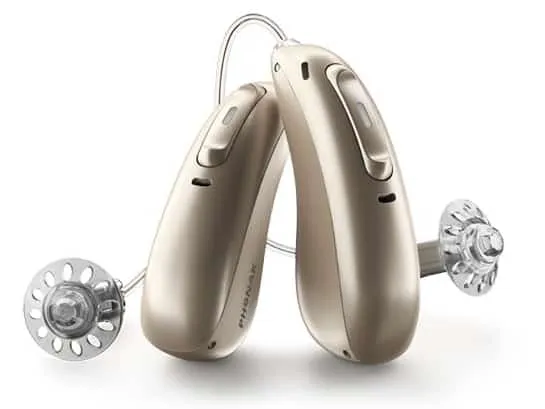This article may contain affiliate links. If you make a purchase through these links, Hearing Insider may receive a small commission at no additional cost to you.
Background noise is the number one complaint among hearing aid users. Even with today’s advanced technology, patients often say: “I hear fine in quiet, but I can’t hear well in noise.” Every new hearing aid claims to solve this, but which brands actually deliver?
As an audiologist with over 12 years of clinical experience, I’ll explain how modern hearing aids reduce background noise, highlight my brand rankings, and share AI-driven advancements that are reshaping hearing care in 2025.
Top Hearing Aid Brands Ranked for Noise Reduction
- Phonak
- Oticon
- GN Resound
- Widex
- Signia
- Starkey
Each brand uses a different philosophy to tackle noise. Your experience depends on your hearing loss type, lifestyle, and listening environments.
AI vs Traditional Noise Reduction
Modern hearing aids no longer rely only on microphones and amplifiers. Artificial Intelligence (AI) has changed the game:
- Phonak AutoSense OS uses AI to scan your environment every 0.4 seconds, switching automatically between speech, music, or noise programs.
- Oticon More & Real use a Deep Neural Network (DNN) trained on 12 million real-world sounds, letting the brain decide what’s speech versus noise.
- Starkey Evolv AI integrates voice processing with extras like fall detection, language translation, and fitness tracking.
- Signia Augmented Focus separates speech and background layers, then recombines them for clarity.
This means today’s hearing aids don’t just reduce background noise—they learn from it.
Comparison: Hearing Aid Brands in Noise
| Brand | Core Technology | Strengths | Weaknesses | Best For |
|---|---|---|---|---|
| Phonak | StereoZoom Beamforming + AutoSense AI | Excellent speech focus in noise, great for restaurants | Can sound narrow | Group conversations, social settings |
| Oticon | DNN Full-Sound Access | Natural, balanced sound | Can feel “too open” in loud places | Active daily users |
| Resound | Asymmetric Directionality + All Access | Flexibility, app control | May confuse the brain in severe losses | Tech-comfortable users |
| Widex | PureSound + Low Delay Processing | Best for music, natural sound | Noise reduction less aggressive | Musicians, sound quality seekers |
| Signia | Augmented Focus + Own Voice Processing | Strong clarity, sleek app | Slightly less natural soundscape | First-time wearers |
| Starkey | AI + Edge Mode | Smart features beyond hearing (falls, health) | Noise handling not as strong | Tech-savvy patients |
Directional Microphones: Still Essential
While AI grabs headlines, directional microphones remain critical. They work by “zooming in” on sounds from the front and dampening noise from behind or the side.
👉 Read more: Everything to Know About Hearing Aids
Phonak: Beamforming Leader

Phonak’s StereoZoom uses adaptive beamforming to focus on speech in front of you.
Phonak’s StereoZoom system synchronizes both hearing aids to create a narrow beam toward the person you’re facing. This provides excellent speech clarity in busy restaurants, meetings, and family gatherings.
👉 Learn more: Phonak Hearing Aids – Answering Common User Questions
Oticon: Brain-Friendly AI

Oticon takes a different approach. Instead of suppressing noise, their DNN-powered hearing aids give the brain access to all sounds, letting you decide what matters. For many patients, this feels more natural and less fatiguing.
👉 Explore more: Oticon Hearing Aids
Resound: Vision-Inspired Technology
Resound uses asymmetric directionality, with one ear directional and the other omnidirectional. This helps maintain awareness while improving focus on speech.
Graphic showing Resound’s All Access Directionality.
👉 See details: Resound Hearing Aids
👉 App control review: Best Hearing Aid Apps Ranked
Widex & Starkey: Specialty Leaders
- Widex: unmatched in music fidelity thanks to ultra-low delay processing.
- Starkey: pioneers of health-tracking hearing aids, adding features like step counting and fall detection.
👉 Starkey resource: Starkey Hearing Aids
👉 Music review: Best Hearing Aids for Musicians
Practical Tips for Hearing in Noise
Even the best technology benefits from smart strategies:
- Use accessories: Remote mics (like Phonak Roger) dramatically boost speech in groups.
- Leverage apps: Fine-tune noise reduction and directionality on your phone.
- Try captions: Pair hearing aids with apps like Live Transcribe or Otter.ai for added clarity.
- Sit smart: Face the speaker, reduce background sources (TV, kitchen noise).
👉 Read: Remote Microphones and Noise Understanding
Future Trends
- Auracast Bluetooth LE Audio → Public spaces (airports, theaters, churches) will stream audio directly to hearing aids.
- Health Integration → Heart rate monitoring, fall detection, and step tracking becoming standard.
- Cloud Updates → Hearing aids can now update firmware, improving noise reduction after purchase.
Final Verdict
No single hearing aid is perfect in every situation.
- Phonak excels in directional speech clarity.
- Oticon offers the most natural, brain-friendly approach.
- Widex is unmatched for music.
- Starkey is leading in smart health features.
Your best choice depends on your hearing loss, lifestyle, and goals. Always work with an experienced audiologist to find the right fit.

